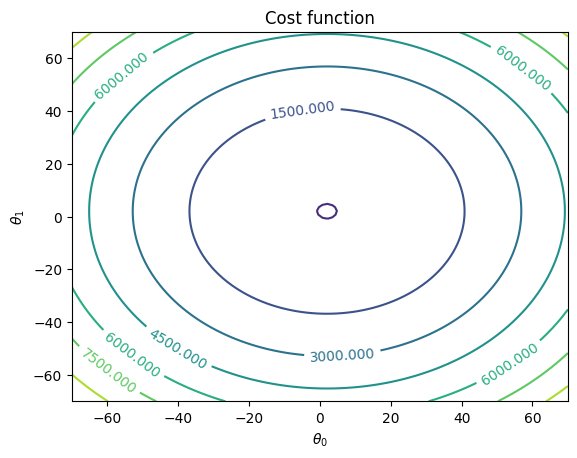Two Variable Newton Raphson#
The Newton-Raphson method can be extended to optimize functions with two or more variables. In this example, we’ll illustrate the Newton-Raphson method using a cost function with two variables \(\theta_1\) and \(\theta_2\). The goal is to minimize the cost function by finding the optimal values of these variables.
Suppose we have the following cost function:
We want to find the minimum of this cost function using the Newton-Raphson method. First, we need to compute the gradient vector and the Hessian matrix. The gradient vector \(\nabla J\) is given by:
The Hessian matrix \(\mathbf{H}\) is given by:
Now, we can apply the Newton-Raphson update rule:
Let’s perform a few iterations of the Newton-Raphson method with an initial guess:
Initialization:
\(\theta_1 = 2.0\)
\(\theta_2 = 2.0\)
Iteration 1:
Calculate the gradient and the Hessian matrix at the current parameters:
\(\nabla J = \begin{bmatrix} 2 \cdot 2 - 4 \\ 2 \cdot 2 - 4 \end{bmatrix} = \begin{bmatrix} 0 \\ 0 \end{bmatrix}\)
\(\mathbf{H} = \begin{bmatrix} 2 & 0 \\ 0 & 2 \end{bmatrix}\)
Update the parameters using the Newton-Raphson formula:
\(\begin{bmatrix} \theta_1 \\ \theta_2 \end{bmatrix}_{k+1} = \begin{bmatrix} \theta_1 \\ \theta_2 \end{bmatrix}_{k} - \mathbf{H}^{-1} \nabla J = \begin{bmatrix} 2 \\ 2 \end{bmatrix} - \begin{bmatrix} 0 \\ 0 \end{bmatrix} = \begin{bmatrix} 2 \\ 2 \end{bmatrix}\)
The algorithm converges after the first iteration because the gradient is zero, indicating that we’ve reached a minimum.
In this example, the Newton-Raphson method finds the optimal values of \(\theta_1\) and \(\theta_2\) that minimize the cost function quickly because it’s a simple quadratic function. In more complex functions, it may require multiple iterations to converge to the minimum.
import numpy as np
def cost_function(x):
# cost function
return x[0]**2 + x[1]**2 - 4*x[0] - 4*x[1]
def gradient(x):
# Calculate the gradient of the cost function.
# For example: return np.array([2 * x[0], 2 * x[1]])
return np.array([2 * x[0]-4, 2*x[1]-4]) # Partial derivative of f with respect to x
def hessian(x):
# Calculate the Hessian matrix of the cost function.
return np.array([[2,0], [0, 2]])
def newton_raphson(initial_guess, max_iterations, tolerance):
x = initial_guess
for iteration in range(max_iterations):
grad = gradient(x)
hess = hessian(x)
if np.linalg.det(hess) == 0:
print("Hessian matrix is singular. Unable to continue.")
break
delta_x = -np.linalg.inv(hess).dot(grad)
x = x + delta_x
if np.linalg.norm(delta_x) < tolerance:
print(f"Converged to solution after {iteration} iterations.")
break
return x
# Set initial guess, maximum iterations, and tolerance
initial_guess = np.array([1.0, -20.0])
max_iterations = 100
tolerance = 1e-6
# Call the Newton-Raphson method
result = newton_raphson(initial_guess, max_iterations, tolerance)
print("Optimal solution:", result)
print("Minimum cost:", cost_function(result))
Converged to solution after 1 iterations.
Optimal solution: [2. 2.]
Minimum cost: -8.0
import matplotlib.pyplot as plt
x = np.linspace(-70, 70, 100)
y = np.linspace(-70, 70, 100)
X = np.meshgrid(x , y)
#theta_hist_array=np.array(theta_history)
cost_values = cost_function(X)
fig, ax = plt.subplots()
CS = ax.contour(X[0],X[1], cost_values)
ax.clabel(CS, inline=True, fontsize=10)
#ax.plot(theta_hist_array[:,0],theta_hist_array[:,1],'go')
ax.set_title('Cost function')
ax.set_xlabel(r'$\theta_0$')
ax.set_ylabel(r'$\theta_1$')
plt.show()


